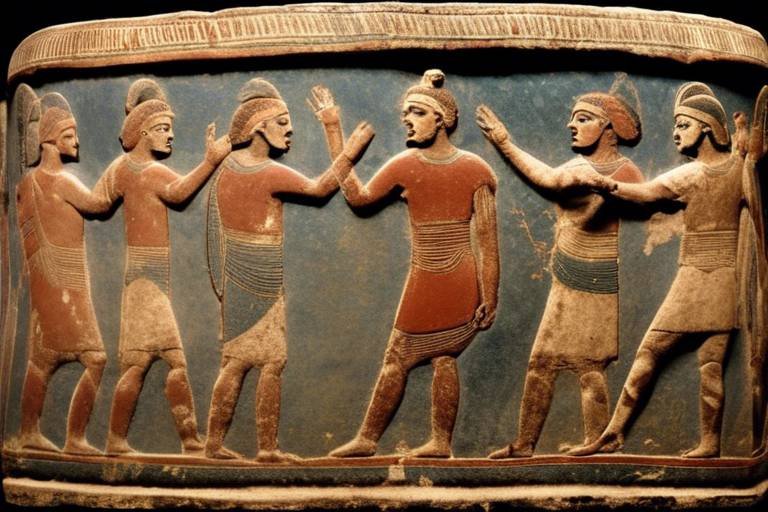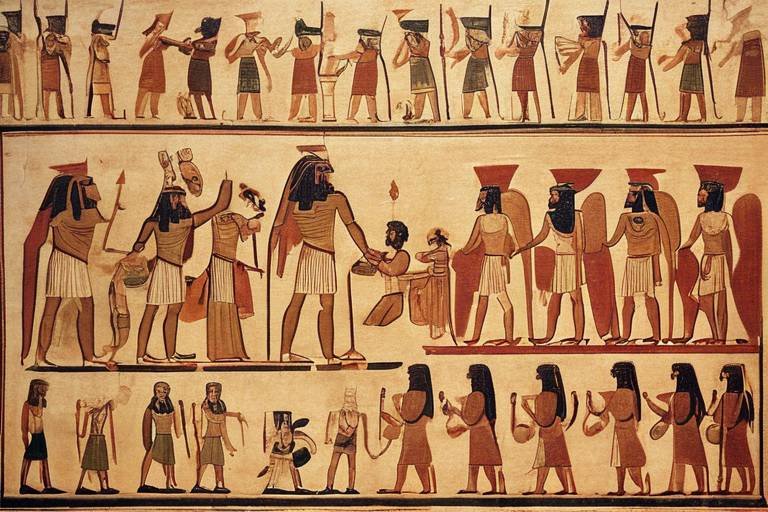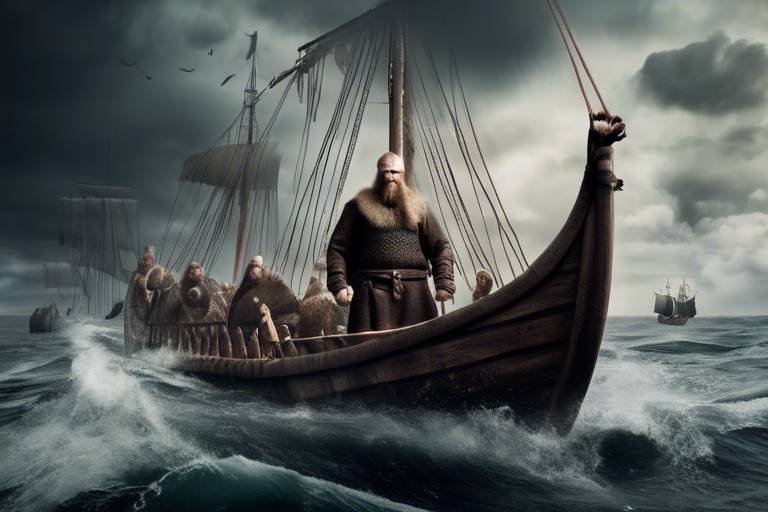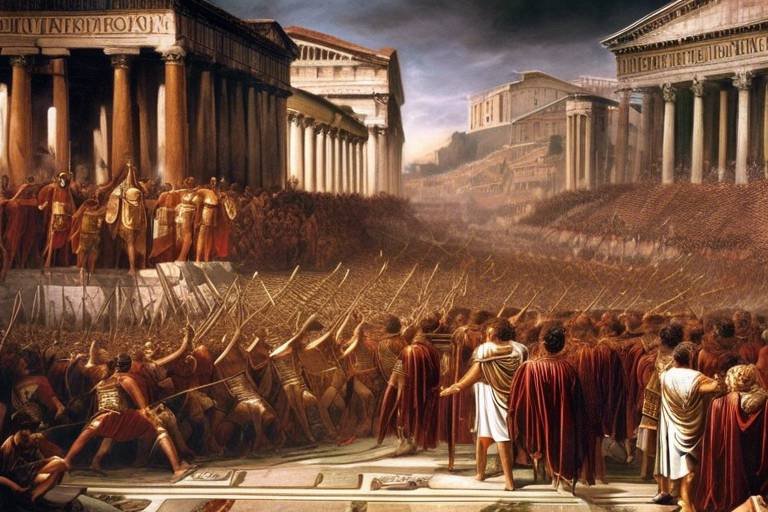The Legacy of the Etruscans - What We Know
The legacy of the Etruscans continues to fascinate and intrigue historians, archaeologists, and art enthusiasts alike. This ancient civilization, which thrived in central Italy before the rise of Rome, has left a lasting impact on art, religion, and society. From their exquisite artworks to their intricate burial practices, the Etruscans have captured the imagination of generations with their mysterious and enigmatic culture.
The art and architecture of the Etruscans are renowned for their unique style and influence on subsequent Roman art and culture. Their elaborate tombs adorned with vibrant frescoes, intricate sculptures depicting daily life and mythological scenes, and exquisite pottery reflect the rich artistic heritage of this civilization. The Etruscans' architectural achievements, such as their advanced engineering feats in constructing underground burial chambers, showcase their skill and creativity.
Delving into the religious beliefs of the Etruscans unveils a complex system of gods, divination practices, and rituals that shaped their worldview. The Etruscans' pantheon of deities, their use of augury to interpret signs from the gods, and their elaborate funeral rites reveal a society deeply connected to the spiritual realm. Their influence on Roman religion, particularly in the realms of prophecy and ritual, is undeniable.
The Etruscan language and writing system remain a subject of fascination and mystery, with scholars still working to decipher its complexities. Inscriptions found on artifacts and tombs provide tantalizing glimpses into Etruscan society, offering clues about their social structure, governance, and daily life. The enigmatic nature of the Etruscan script adds an air of intrigue to the study of this ancient civilization.
Exploring the social organization and governance of the Etruscans reveals a society structured around city-states, aristocratic families, and intricate political systems. Their interactions with neighboring civilizations, such as the Greeks and the Phoenicians, shaped their trade networks, economy, and cultural exchanges. The Etruscans' maritime trade prowess and metalworking skills made them key players in the ancient Mediterranean world.
The Etruscans' elaborate burial customs and funerary practices provide valuable insights into their beliefs about the afterlife and the honoring of the deceased. The grandeur of their tomb architecture, the wealth of grave goods accompanying the deceased, and the rituals performed to ensure a smooth passage to the next life all speak to the importance they placed on death and the afterlife.
The influence of the Etruscans on early Rome cannot be overstated, with elements of Etruscan culture permeating Roman religion, art, and urban planning. The merging of Etruscan and Roman traditions gave rise to a unique identity that shaped the development of the Roman Empire. The legacy of the Etruscans lives on in the foundations of Western civilization.
Recent archaeological discoveries and scholarly interpretations continue to shed new light on the enigmatic Etruscans, sparking debates and discussions about their legacy in the modern world. Ongoing research efforts aim to unravel the mysteries surrounding this ancient civilization and deepen our understanding of their contributions to art, religion, and society.

Etruscan Art and Architecture
Exploring the enduring impact of the ancient Etruscans on art, religion, and society. Delve into their mysterious civilization, from their advanced engineering feats to their unique language and burial practices.
The Etruscans left a remarkable legacy in the realm of art and architecture, influencing not only their contemporaries but also future civilizations like the Romans. Their artistic style was characterized by intricate details and vibrant colors, evident in the exquisite sculptures, pottery, and frescoes found in their tombs.
One of the most fascinating aspects of Etruscan art is their mastery of terracotta sculpture, showcasing a level of realism and emotional depth that was ahead of its time. These sculptures often depicted scenes from daily life, mythology, and religious rituals, providing a glimpse into the cultural richness of Etruscan society.
In terms of architecture, the Etruscans were known for their innovative engineering techniques, such as the construction of underground tombs and elaborate city walls. Their architectural achievements not only served practical purposes but also reflected their artistic sensibilities, blending functionality with aesthetic appeal.
Moreover, Etruscan architecture heavily influenced Roman architectural styles, particularly in the use of arches, vaults, and urban planning. The Romans adopted and adapted many Etruscan architectural elements, incorporating them into their own monumental structures and city layouts.
In conclusion, the Etruscans' artistic and architectural contributions continue to captivate scholars and art enthusiasts alike, offering a glimpse into a civilization that thrived in creativity and innovation.

Etruscan Religion and Beliefs
The Etruscans had a complex and rich religious system that played a significant role in their society. Their beliefs were deeply intertwined with their daily lives, influencing everything from governance to personal decisions. Central to Etruscan religion was their pantheon of gods, which included deities such as Tinia, Uni, and Menrva. These gods governed various aspects of life, from agriculture to war, and were worshipped through rituals and sacrifices.
One of the most distinctive features of Etruscan religion was their practice of divination, the art of interpreting signs and omens to predict the future. Etruscans believed that the gods communicated with them through natural phenomena such as lightning, thunder, and the behavior of birds. Priests, known as haruspices, would examine the entrails of sacrificed animals to foretell events and guide decision-making.
Rituals played a crucial role in Etruscan religious practices, with ceremonies held to honor the gods and ensure prosperity and protection for the community. These rituals often involved feasting, music, and processions to sacred sites. The Etruscans also placed great importance on burial practices, believing in an afterlife where the soul continued its journey.
Their beliefs in the afterlife influenced their burial customs, with elaborate tombs constructed to house the deceased along with offerings and possessions for the journey beyond. The Etruscans believed in the importance of honoring the dead and maintaining a connection with the spiritual realm through these burial practices.

Etruscan Language and Writing
Exploring the enduring impact of the ancient Etruscans on art, religion, and society. Delve into their mysterious civilization, from their advanced engineering feats to their unique language and burial practices.
The Etruscans had a unique language and writing system that still puzzles scholars today. Their script, known as Etruscan or Etruscan alphabet, is a script used in ancient Italy by Etruscans. It is believed that their language was not Indo-European and was unrelated to any other known language. The Etruscan language is mostly known through inscriptions found on various artifacts, such as the famous Pyrgi Tablets, which contain bilingual inscriptions in Etruscan and Phoenician.

Etruscan Society and Governance
The Etruscans had a complex society with a hierarchical structure that influenced their governance and daily life. At the top of the social hierarchy were the aristocrats, who held political power and controlled the resources of the city-states. These aristocrats formed an elite class that governed Etruscan society, making decisions on matters such as trade, warfare, and religious practices. Beneath the aristocracy were the common people, including farmers, artisans, and merchants, who played vital roles in the economy and supported the aristocrats through their labor and taxes.
City-states were the primary political units of Etruscan society, each governed by a monarch or a group of aristocrats. These city-states, such as Veii, Tarquinia, and Vulci, maintained their independence while also forming alliances and engaging in conflicts with neighboring states. The Etruscans' city-state system allowed for a degree of autonomy and self-governance, with each city-state having its own laws, customs, and governing structures.
Religious beliefs also played a significant role in Etruscan governance, as the Etruscans believed that the gods influenced human affairs and the fate of the state. The Etruscans practiced divination, seeking guidance from the gods through rituals such as haruspicy, the examination of animal entrails. These religious practices were intertwined with political decision-making, with rulers consulting priests and oracles to ensure the favor of the gods and the success of their endeavors.
Trade and commerce were essential aspects of Etruscan society, with city-states engaging in maritime trade and establishing economic ties with other civilizations. The Etruscans were known for their metalworking skills, producing goods such as bronze sculptures, jewelry, and weapons that were highly valued in the ancient world. Trade networks extended to Greece, Phoenicia, and beyond, bringing wealth and cultural exchange to the Etruscan cities.
The governance of Etruscan society was characterized by a blend of aristocratic rule, religious influence, and economic prosperity. The intricate social structure, city-state system, and reliance on divine guidance shaped the way the Etruscans governed themselves and interacted with the world around them. Through their society and governance, the Etruscans left a lasting legacy that continues to fascinate and intrigue modern scholars and enthusiasts.

Etruscan Trade and Economy
The Etruscans were renowned for their thriving trade networks and robust economy, which played a pivotal role in their civilization's prosperity and influence. Their strategic location along the Tyrrhenian Sea facilitated maritime trade with various Mediterranean cultures, including Greece and Phoenicia. The Etruscans excelled in metalworking, producing exquisite bronze artifacts highly sought after in the ancient world. Their mastery of naval technology enabled them to dominate sea routes, expanding their commercial reach far and wide.
One of the key aspects of Etruscan trade was their establishment of emporia, or trading posts, in strategic locations across the Mediterranean. These emporia served as hubs for commerce, facilitating the exchange of goods and ideas between different civilizations. Through these trading outposts, the Etruscans not only engaged in economic transactions but also fostered cultural exchange, influencing art, architecture, and religious practices in the region.
The Etruscan economy was characterized by a sophisticated system of production and distribution. Their agricultural prowess, particularly in viticulture and olive cultivation, provided a stable foundation for their economy. Additionally, the Etruscans engaged in mining activities, extracting valuable metals such as copper, iron, and tin, which were essential for their metalworking industry. This abundance of resources fueled their economic growth and technological innovation.
Trade played a significant role in the wealth and power of Etruscan city-states, fostering economic competition and cooperation among different regions. The prosperity generated by trade allowed the Etruscans to invest in monumental public works, such as temples, walls, and infrastructure, showcasing their wealth and cultural sophistication. The economic success of the Etruscans not only bolstered their influence in the ancient world but also contributed to the legacy they left behind for future generations to unravel.

Etruscan Burial Customs
Etruscan Burial Customs were a significant aspect of their culture, reflecting their beliefs about the afterlife and honoring the deceased. The Etruscans had elaborate funerary practices that involved intricate tomb architecture, grave goods, and rituals. These customs were a way to ensure a smooth transition for the deceased into the next world and to show respect for their journey beyond life.
One of the most remarkable features of Etruscan burial customs was their tomb architecture. The Etruscans built elaborate underground tombs, often adorned with intricate frescoes depicting scenes from daily life, mythology, and religious beliefs. These tombs were designed to be eternal homes for the deceased, showcasing the importance of the afterlife in Etruscan culture.
Grave goods were another essential part of Etruscan burial practices. The deceased were often buried with personal belongings, jewelry, pottery, and other items that were believed to be necessary for their journey to the afterlife. These grave goods not only served a practical purpose but also symbolized the status and identity of the deceased in the next world.
Rituals played a crucial role in Etruscan burials, with ceremonies conducted to honor the dead and ensure their peaceful passage into the afterlife. These rituals included feasting, mourning, and offerings to the gods to secure the favor and protection of the deceased in the underworld. The Etruscans believed in maintaining a strong connection with the spirits of their ancestors, seeking guidance and protection from the other side.
Overall, Etruscan burial customs were intricate and deeply rooted in their spiritual beliefs and societal values. The elaborate tombs, rich grave goods, and solemn rituals all reflected the Etruscans' reverence for the deceased and their profound understanding of the cycle of life and death.

Etruscan Influence on Rome
The influence of the Etruscans on Rome was profound and far-reaching, shaping the early development of the Roman civilization in various aspects. One of the most significant impacts was seen in the realm of religion, where Etruscan religious practices and beliefs heavily influenced Roman spirituality. The Romans adopted many Etruscan gods and divination methods, integrating them into their own religious practices. This fusion of Etruscan and Roman religious elements laid the foundation for the complex Roman pantheon that would evolve over time.
Furthermore, the Etruscans played a crucial role in shaping Roman art and culture. Etruscan artistic styles and techniques, such as sculpture and pottery, were assimilated by the Romans and incorporated into their artistic endeavors. The Etruscans' emphasis on intricate details and expressive forms left a lasting mark on Roman art, influencing the development of Roman sculpture and painting.
In addition to religion and art, the Etruscans also impacted Roman urban planning and architecture. The Etruscans were skilled engineers and city planners, known for their advanced construction techniques and infrastructure development. Roman cities, influenced by Etruscan models, adopted elements of Etruscan urban design, including the layout of streets, public buildings, and drainage systems.
Moreover, the Etruscans introduced the Romans to the concept of gladiatorial games, which eventually became a prominent feature of Roman entertainment and culture. The Etruscans' love for spectacle and public games influenced the Romans' fascination with violent sports and theatrical performances, shaping the entertainment industry in ancient Rome.
Overall, the Etruscan influence on Rome was multifaceted and enduring, leaving a lasting legacy that permeated various aspects of Roman society. By examining the impact of the Etruscans on Rome, we gain valuable insights into the cultural exchange and assimilation that characterized the ancient Mediterranean world.

Modern Discoveries and Interpretations
Modern Discoveries and Interpretations have brought new insights into the enigmatic civilization of the Etruscans. Recent archaeological findings have uncovered previously unknown aspects of their daily life, art, and societal structures. Scholars are continuously reevaluating existing knowledge and theories about the Etruscans based on these discoveries. The ongoing research aims to unravel the mysteries surrounding this ancient civilization and provide a clearer understanding of their legacy.
Frequently Asked Questions
- What is the significance of Etruscan art and architecture?
Etruscan art and architecture hold great importance as they heavily influenced Roman art and culture. The Etruscans were known for their distinctive artistic style seen in their tombs, sculptures, and pottery, showcasing their rich cultural heritage. Their architectural achievements also played a significant role in shaping the urban landscape of ancient Italy.
- How did Etruscan burial customs reflect their beliefs?
The elaborate burial customs of the Etruscans, including tomb architecture, grave goods, and rituals, reflected their strong beliefs about the afterlife and their respect for the deceased. These practices provide valuable insights into their society's values and worldview, highlighting the importance they placed on honoring the dead.
- What impact did the Etruscans have on Roman society?
The Etruscans had a significant influence on early Rome, shaping various aspects of Roman religion, art, and urban planning. Their culture merged with Roman society, contributing to the development of a unique Roman identity. Understanding the Etruscan influence is crucial for comprehending the origins of Roman civilization.
- Why is the Etruscan language and writing system still largely undeciphered?
The Etruscan language and writing system remain a mystery to scholars due to the limited number of surviving texts and the complexity of the script. Deciphering the Etruscan language presents a significant challenge, hindering full understanding of this ancient civilization's literature and historical records.
- How did Etruscan trade networks contribute to their economic prosperity?
The Etruscans were renowned for their maritime trade and metalworking skills, which enabled them to establish extensive trade networks with regions such as Greece and Phoenicia. These commercial relationships played a vital role in the Etruscans' economic prosperity and cultural exchange, enriching their society with valuable resources and knowledge.



















